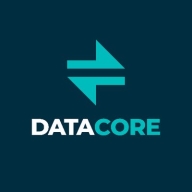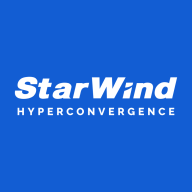


DataCore SANsymphony and StarWind Virtual SAN compete in the storage solutions category. DataCore has the upper hand in features with its advanced auto-tiering and synchronous mirroring, while StarWind leads in deployment simplicity.
Features: DataCore SANsymphony offers high availability, flexible hardware utilization, and auto-tiering to efficiently manage different storage tiers. It enables synchronous mirroring for robust redundancy and data protection. StarWind Virtual SAN provides active-active high availability, easy installation, and flexibility in deployment, making it cost-effective for various hardware configurations. It offers fast setup and strong integration capabilities, ensuring minimal downtime and reliable performance.
Room for Improvement: DataCore SANsymphony needs better integrated reporting tools, enhancements in enterprise support, and improved manageability. StarWind Virtual SAN could enhance its documentation, performance reporting, and management interface. It would benefit from more comprehensive monitoring capabilities to aid deployment and management processes efficiently.
Ease of Deployment and Customer Service: DataCore SANsymphony is praised for exceptional technical support and rapid response times, which make deployment smoother despite its complex setup. StarWind Virtual SAN is valued for its straightforward deployment and minimal setup complexity, paired with a capable support team known for high responsiveness and expertise.
Pricing and ROI: DataCore SANsymphony provides a strong ROI with flexibility in hardware upgrades without altering licensing, though the subscription can become costly over time. StarWind Virtual SAN is recognized for cost-effectiveness, especially for SMBs, with simple pricing and excellent value, allowing affordable scaling as storage needs expand.
It does not require much management once you set up correctly, so it saves time, allowing an admin to focus on other work.
We don't sell a lot of redundant servers, so it's not a massive ROI, but the ability to rely on their technical support and the software's ease of setup allows us to reduce labor costs and go to market competitively.
The cost benefits, as far as we consider, are much better with a StarWind VSAN solution, and the training requirements with the ease of administration simplify and reduce our administrator and professional services costs.
Regarding cost savings, for my client, it was about 20K USD for his specific use and as for extending capacity, StarWind made that process easy.
I would rate them an eight out of ten.
The support is done through email and is not that great, making it a very problematic area I've been dealing with for over four years.
Their technical support has been perfect lately, so I would give it a 10.
They always help me quickly and with great knowledge, which is essential for central storage.
I would rate technical support from DataCore SANsymphony a 10.
The customer support is perfect.
Even in the instances where my technical team does not have the ability to manage or troubleshoot or resolve an issue, StarWind's technical team supports and resolves on our behalf very quickly.
They have some awesome guides online that show you exactly how to configure the product, how to do the initial setup, and you can speak with them directly who will be able to connect, verify your setup, run its parameters, and see exactly what's working and what is not, and adjust it, and they really help you with that.
The customer support from StarWind Virtual SAN is great, as the people are knowledgeable and have great knowledge about the product and the functionality we require in the system.
Pure Storage FlashBlade is scalable.
There are between 5 and 10,000 people using it in our organization.
There are no limits to scalability, which is essential for central storage.
If we want to expand our storage or add disks, it is easy to add them, configure the RAID, and then deploy it.
I believe that scalability should be further improved, especially considering the possibility that environments may grow exponentially.
When you move from a two-node cluster to a three-node cluster, you have to completely redo the way that they are connected to each other with iSCSI.
In case there is any issue with any blade, the data is moved to another.
In my experience, StarWind Virtual SAN is very stable, and I have never had a single instability issue.
It has been working for five years and the customer is still happy with it.
I ran it on a two-node Hyper-V cluster setup, and I didn't experience any unexpected crashes or major issues.
Technical support definitely needs significant improvement.
Its configuration should be easier.
One way Pure Storage FlashBlade can be improved is by having more compatibility between the FlashArray and FlashBlade.
there should be improvements in how to get and filter logs
The area of DataCore SANsymphony that has room for improvement is the support.
DataCore SANsymphony can be improved with high availability as it offers synchronous mirroring between physical and separate sites to ensure business continuity and disaster recovery.
A more intuitive interface or an improved dashboard for monitoring the cluster would also be helpful, as it would facilitate performance tracking and help identify potential issues before they affect services.
There have been cases where not understanding exactly what's failing on the Virtual SAN has been an issue.
Limited feedback in the management GUI is the main area where I would like to see StarWind Virtual SAN get better.
The pricing of Pure Storage FlashBlade is expensive compared to other products I used from other companies in the past, but one benefit is that they have built-in ransomware protection.
Regarding pricing, it is okay; we needed exactly this in size, and the price was a lot lower than competitors, making it good for us.
They have made some improvements regarding the pricing, but it's still too expensive.
The cost changed from a perpetual license to a subscription model.
The costs are acceptable and very competitive compared to other hardware-only HCI solutions.
I talked to the sales team, they gave me a quote with a perpetual license with the support and everything went through smoothly.
This is a great product and good support even you are using free version!
We can plug in many blades, and we can have data up to one terabyte.
The best features of Pure Storage FlashBlade include better throughput and better performance.
Pure Storage FlashBlade's scalability is one of the most valuable features, and importantly, it always works, allowing for seamless upgrades.
Customers can extend storage with flexibility, as one is not obligated to purchase hard disks or controllers from the same storage vendor.
DataCore SANsymphony's ability to enhance storage utilization is very good because it's agnostic and it can be deployed on every environment, which is perfect for my clients.
This flexibility and scalability have helped our organization in practice because it is important for us as it decouples the storage management software from the physical hardware, creating a software layer of intelligence.
Thanks to its seamless integration with Proxmox, the implementation of high availability servers has drastically reduced downtime, which is crucial for our security-focused company.
StarWind Virtual SAN helps us keep customer satisfaction and provides the solutions we need without having to hire many IT specialists.
StarWind's storage virtualization and failover capabilities have made a difference for my clusters through uptime improvements, with zero downtime specific to server host maintenance or even maintenance of the StarWind software itself.
| Product | Market Share (%) |
|---|---|
| StarWind Virtual SAN | 5.5% |
| DataCore SANsymphony | 6.3% |
| Pure Storage FlashBlade | 3.3% |
| Other | 84.9% |



| Company Size | Count |
|---|---|
| Small Business | 11 |
| Midsize Enterprise | 11 |
| Large Enterprise | 21 |
| Company Size | Count |
|---|---|
| Small Business | 36 |
| Midsize Enterprise | 12 |
| Large Enterprise | 21 |
| Company Size | Count |
|---|---|
| Small Business | 165 |
| Midsize Enterprise | 54 |
| Large Enterprise | 34 |
FlashBlade is the industry’s most advanced scale-out storage for unstructured data, powered by a modern, massively parallel architecture to consolidate complex data silos (like backup appliances and data lakes) and accelerate tomorrow’s discoveries and insights.
Experience peace of mind with DataCore SANsymphony, the ultimate software-defined storage solution alleviating storage management challenges. Say goodbye to the complexities of managing different storage tiers and disruptions with SANsymphony's block-level storage virtualization technology, empowering you to automate capacity provisioning and data placement across diverse storage environments including SAN, DAS, HCI, and JBOD. Break down silos, control data placement, meet business continuity objectives, boost performance, and seamlessly expand or refresh hardware with SANsymphony. Benefit from features like asynchronous replication for disaster recovery, minimizing data loss, accelerating application responsiveness, and integrating new technology non-disruptively. Trusted by industry leaders like NASA, Thorntons, Inc., and TUI Cruises, DataCore SANsymphony guarantees unparalleled flexibility, scalability, and reliability, ensuring uninterrupted data access and application availability while reducing storage costs and inefficiencies.
StarWind Virtual SAN provides high availability and fault tolerance for virtualized environments without the need for dedicated SAN hardware. It allows for real-time replication between servers, shared storage for Hyper-V clusters, and enables vMotion and High Availability features for VMware vSphere. The solution reduces costs and leverages existing hardware while providing a scalable and reliable infrastructure. Valuable features include ease of use, scalability, top-tier support, hardware agnosticism, and the ability to use off-the-shelf standard servers to increase storage space. StarWind VSAN has helped organizations improve performance, data availability, and data security while reducing downtime and providing cost-saving storage options.
We monitor all Software Defined Storage (SDS) reviews to prevent fraudulent reviews and keep review quality high. We do not post reviews by company employees or direct competitors. We validate each review for authenticity via cross-reference with LinkedIn, and personal follow-up with the reviewer when necessary.